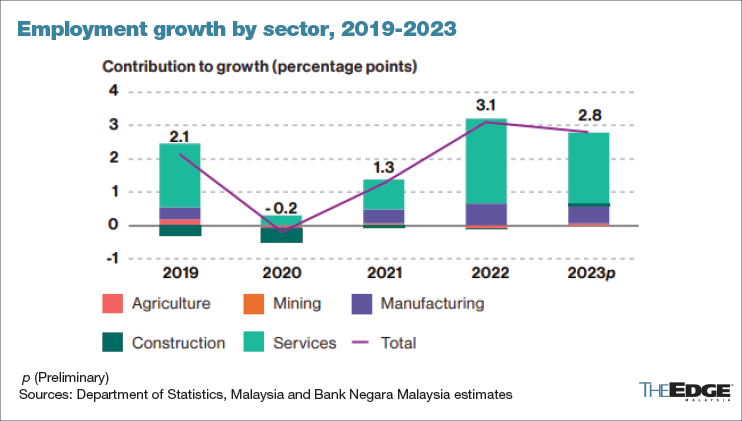
KUALA LUMPUR (March 20): Bank Negara Malaysia expects wages to increase further in 2024 following slowdown last year, while the jobless rate will likely remain stable near its past trend.
Employment is projected to continue expanding, thanks to sustained demand for workers amid the ongoing recovery in tourism-related sectors and external trade activity, BNM said in the Economic and Monetary Review 2023 released on Wednesday.
The central bank also anticipates the unemployment rate to stabilise around its historical average of 3.3% in 2024, a level economists generally consider as full employment. Unemployment rates have declined to pre-pandemic levels, reaching 3.4% in 2023.
Aggregate nominal wage growth for the private sector fell to 3.7% in 2023 from 6.7% in 2022, while that of the public sector edged higher during the year to 6.1% from 5%.
Labour force participation reached a historic high of 70.2% in December 2023, thanks to increased opportunities in gig work.
According to BNM, employment grew slower at 2.8% in 2023 versus the 3.1% growth in 2022, with own-account workers — individuals who operate their own farm, business or trade on a full-time basis without employing any paid workers — being a significant contributor compared to pre-pandemic years.
“This was likely due to the rise of gig workers, as both displaced workers and new entrants into the labour force joined the gig economy amid trends such as the strong demand for food delivery,” it stated.
In terms of demographic, female participation in the labour force rose to 56.2% in 2023 from 55.8% in 2022, particularly among those with tertiary education, on the back of higher education enrollment among women in recent years. Meanwhile, the labour participation rate for men during the year also rose to 82.8% from 81.9%.
Semi-skilled workers remained the largest employment share at 59.1% in 2023, though marginally smaller than the 59.6% in 2022.
Employment sustained by domestic sectors amid weak external demand
Touching on the employment sectors, BNM noted that employment was broadly sustained in domestic-oriented economic sectors, despite weaker external demand during the year.
Through industrial engagements, the central bank found that firms intended to retain workers due to concerns over difficulties and the high cost of rehiring when external demand recovers.
Select high-touch services subsectors observed increased hiring of workers amid improved tourism activities. In particular, the food-and-beverages, accommodation, and wholesale-and-retail trade subsectors were major drivers of overall employment growth during the year.
Meanwhile, employment in the construction sector rebounded due to the faster progress of multi-year investment projects, amid continual easing of labour supply constraints throughout the year.
However, the Social Security Organisation’s (Socso) Employment Insurance System (EIS) reported that jobless claims rose by 45.3% to 49,982 in 2023, from 34,388 in 2022, mainly contributed by the manufacturing sector and wholesale and retail trade subsector.
In terms of wage growth, the manufacturing sector registered a lower growth of 3.5%, compared to 5.2% in 2022. While the moderation was broad-based across most subsectors in the manufacturing sector, it was particularly evident in the export-oriented industries due to the moderation in external demand and the global technology downcycle.
Overall, labour productivity growth, measured by real value added per hour worked, moderated to 0.2% in 2023, compared to 1.8% in 2022. The manufacturing sector recorded the largest decline in productivity growth, as production in the electrical and electronics subsector slowed, while employment remained relatively strong.
Don't miss the other highlights of the BNM Annual Report 2023. Read the articles here.

